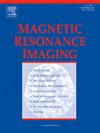基于边缘增强低秩张量分解的三维磁共振图像去噪。
IF 2.1
4区 医学
Q2 RADIOLOGY, NUCLEAR MEDICINE & MEDICAL IMAGING
引用次数: 0
摘要
磁共振图像去噪是为了从感染版本中获得高质量的图像。近年来,低秩张量(LRT)方法在MRI去噪中取得了巨大的成功。然而,这些纯LRT模型无法充分利用干净MRI的综合固有信息。为了克服这些缺点,我们设计了一种新的边缘增强低秩张量近似(EELRTA)框架来去除噪声。将描述局部结构信息的张量梯度L0范数正则化方法引入加权核张量秩模型中,提高了纹理边缘保持能力。权重的应用可以进一步保留分布在具有不同物理含义的不同核心张量系数上的潜在有用信息。采用非局部自相似策略对EELRTA模型进行低秩稀疏激励,增强了模型的抗噪能力。该方法采用一种高效的交替方向乘法器(ADMM)来解决。仿真和多发性硬化症病变(MSL)数据的实验结果表明,该方法可以有效地去除噪声,同时合理地保留病理结构信息。本文章由计算机程序翻译,如有差异,请以英文原文为准。
Denoising of 3D magnetic resonance images via edge-enhanced low-rank tensor decomposition
Magnetic Resonance images (MRI) denoising is to obtain high quality image from infectant version. Recently, low-rank tensor (LRT) methods have been developed and attained resounding success in MRI denoising. However, these pure LRT models are incapable of utilizing the comprehensive inherent information of clean MRI. To overcome these drawbacks, we design a novel edge-enhanced low-rank tensor approximation (EELRTA) framework for Rician noise removal. The tensor gradient L0 norm regularization with describing the local structure information is incorporated into the weighted core tensor rank model for improving texture edge preservation. The application of weights can further preserve the potentially useful information distributed on the different core tensor coefficients with different physical meanings. What's more, non-local self-similarity tactic is employed for low-rank sparsity-encourage and enhancing anti-noise capability of EELRTA model. The proposed EELRTA method is tackled by an efficient alternating direction method of multipliers (ADMM). The Experiment results on simulation and multiple sclerosis lesion (MSL) data illustrate that the proposed method can effectively remove noise while reasonably retaining pathological structure information.
求助全文
通过发布文献求助,成功后即可免费获取论文全文。
去求助
来源期刊

Magnetic resonance imaging
医学-核医学
CiteScore
4.70
自引率
4.00%
发文量
194
审稿时长
83 days
期刊介绍:
Magnetic Resonance Imaging (MRI) is the first international multidisciplinary journal encompassing physical, life, and clinical science investigations as they relate to the development and use of magnetic resonance imaging. MRI is dedicated to both basic research, technological innovation and applications, providing a single forum for communication among radiologists, physicists, chemists, biochemists, biologists, engineers, internists, pathologists, physiologists, computer scientists, and mathematicians.
 求助内容:
求助内容: 应助结果提醒方式:
应助结果提醒方式:


